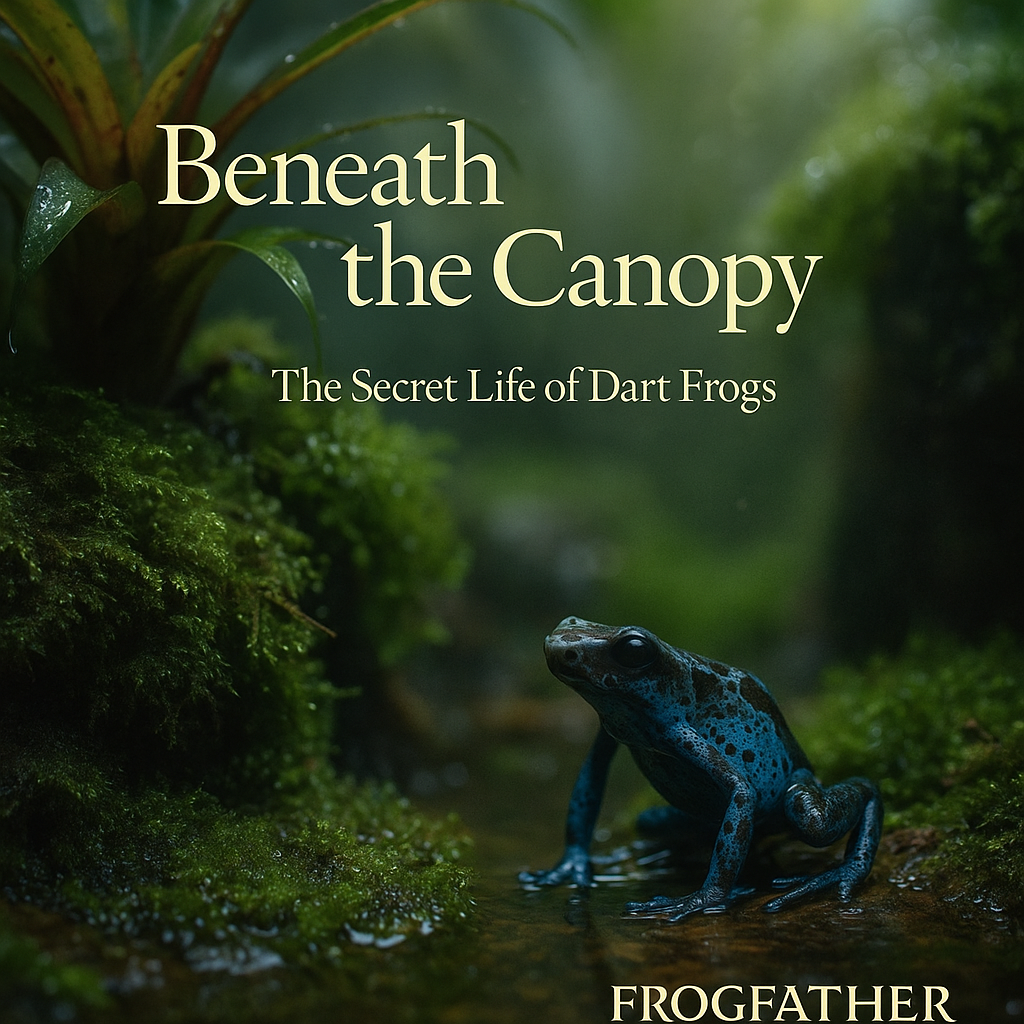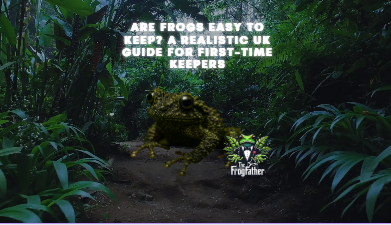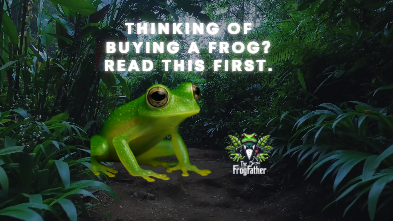Morning begins not with light, but with sound. A soft hiss of mist, a single drop landing on glass, and the gentle call of a frog somewhere unseen. In the filtered glow of the vivarium, life stirs beneath the canopy — quiet, deliberate, ancient.
The Awakening
As humidity rises, moss swells with colour. Leaves unfurl and catch the day’s first droplets. From the crook of a bromeliad, a Ranitomeya variabilis peers out — skin slick with dew, eyes reflecting the soft pulse of light. For a creature no bigger than a thumbnail, this world is vast: a rainforest in miniature, sustained by rhythm and light.
Each movement seems choreographed. The frog tests the air, clambers along a slick stem, then pauses — poised between shadow and beam. It isn’t random. Dart frogs rely on micro-climates of warmth, reflection and scent. What looks still to us is alive with information: the smell of damp wood, the gleam of prey, the faint tremor of a droplet falling somewhere beyond the leaves.
The Language of Light
For humans, light illuminates. For frogs, it communicates. Their eyes perceive ultraviolet wavelengths, reading subtle cues that define safety, hunger and potential mates. Under full-spectrum LEDs such as the Arcadia Jungle Dawn Light Risers, these cues return — a recreation of rainforest geometry where colour and shadow dictate behaviour.
To a frog, the edge of a bromeliad gleams differently at dawn than at dusk. The sheen of moisture changes tone as humidity climbs. What we see as decoration — a waxy leaf, a glint of condensation — is to them a map of survival.
Parenthood in Miniature
Among the leaves, a pair begins their ritual. One male hums softly, vibrations rolling through the substrate. The female answers, tracing a slow spiral until they meet. When their eggs are laid, the male guards them with near-ritual devotion, keeping them moist, free of fungus, protected from mites. When the time comes, he lifts the tadpoles one by one onto his back, carrying them through the dripping labyrinth to tiny pools in bromeliads above.
These pools — the “nurseries” of the rainforest — are shallow cups of water, rich in micro-life. In captivity, we replicate them with precision: Bromelihook egg-laying sites, delicate leaf axils, or removable film canisters nestled among moss. Each choice mirrors a behaviour millions of years old.
The Bioactive Symphony
Underfoot, the unseen orchestra of a bioactive ecosystem performs. Isopods sift detritus; springtails rise and vanish like living dust. Bacteria break down waste into nutrients, feeding roots that anchor the entire structure. It is a loop — self-cleaning, self-balancing, alive. The frogs depend on it, and in return, their movements redistribute moisture and seed microbial life across the terrarium.
This is why the Bioactive Vivarium Kit exists: to simplify complexity without breaking the loop. Soil, fauna and flora converge, reducing the keeper’s intervention while increasing the authenticity of the habitat. The result isn’t decoration; it’s a functioning ecosystem measured in humidity, pH and patience.
Rain and Rhythm
Every few hours, the mist returns — not from clouds, but from the Smart Spray Misting System. It imitates the rainforest’s natural pulse, allowing moisture to collect, fall, and re-evaporate. Frogs recognise this rhythm; it’s their signal to feed, to call, sometimes to breed. Watch closely and you’ll see the pattern: mist, movement, silence, song.
Predators of the Invisible
To the untrained eye, a dart frog’s meal barely exists. Fruit flies hover like dust motes; springtails disappear before they’re noticed. Yet each frog can track movement across mere millimetres. Their accuracy borders on mathematical — a flash of the tongue, a swallow, and equilibrium restored. The vivarium thrives because of these tiny acts repeated thousands of times a day.
The Keeper’s Perspective
From outside the glass, we become witnesses — caretakers of micro-worlds. Every adjustment of light, every new leaf or branch changes their universe. When the tank fogs over, reflections blur the line between our world and theirs. What remains is motion, colour, and sound: the simple truth that life flourishes when given the right conditions.
Technology and Respect
Modern technology has made it possible to sustain rainforest ecosystems within the United Kingdom’s living rooms. Yet the goal is not control, but empathy. Digital sensors measure temperature; 3D-printed fixtures reduce waste; smart lighting replicates dawn and dusk. But beneath all of it lies an older understanding — that every species, no matter how small, perceives its world as fully as we perceive ours.
Quiet Lessons from the Canopy
Frogs teach patience. They remind us that life operates best when allowed to find balance. That humidity, decay and light are not opposites but collaborators. In the hum of a terrarium, there’s an echo of the rainforest — a sound older than language, softer than machinery, and essential to the survival of more than frogs alone.
Final Reflection
As evening falls, the calls quieten. Mist returns, and the frogs retreat into shadows, trusting the night to protect what the day revealed. Beyond the glass, we dim the lights, careful not to disturb the rhythm. Tomorrow, the cycle will begin again — dew, light, life — beneath the canopy.
❓ FAQ
Q: What species are shown in Beneath the Canopy?
Primarily Ranitomeya variabilis and Dendrobates tinctorius species, chosen for their bright colouration and fascinating parenting behaviours.
Q: Can dart frogs really live in a planted bioactive tank?
Yes — a balanced bioactive setup mimics rainforest ecosystems and supports both frog health and natural behaviour.
Q: How do I recreate the lighting and humidity shown?
Use full-spectrum LEDs like the Arcadia Jungle Dawn on risers, paired with automated misting cycles to maintain 80–100 % humidity and stable warmth.
Q: What’s the benefit of 3D-printed vivarium parts?
They’re durable, sustainable, and designed for precise fit — reducing waste while improving airflow and light distribution in small enclosures.



